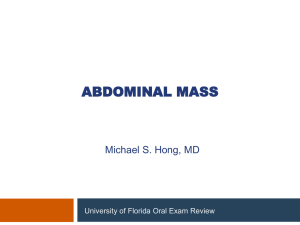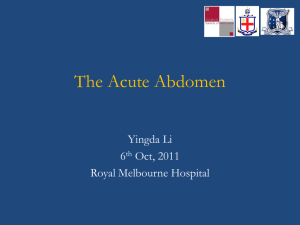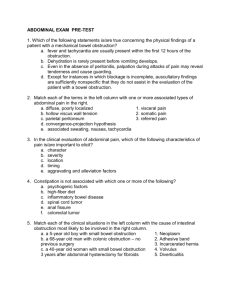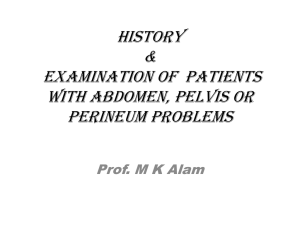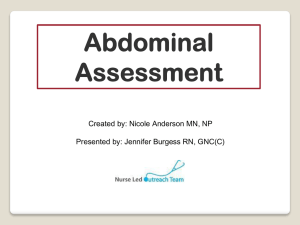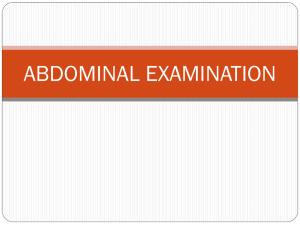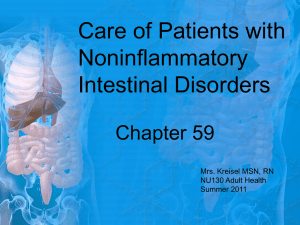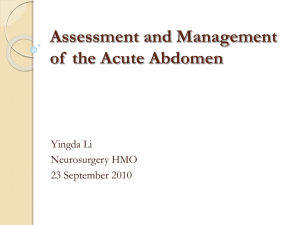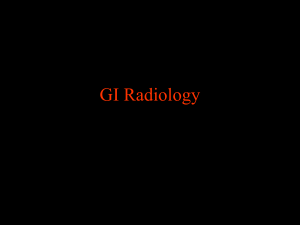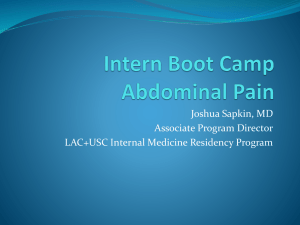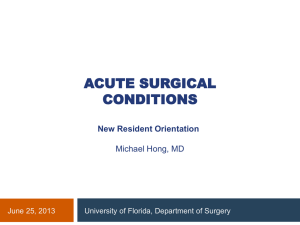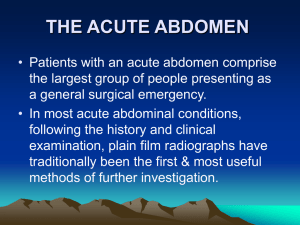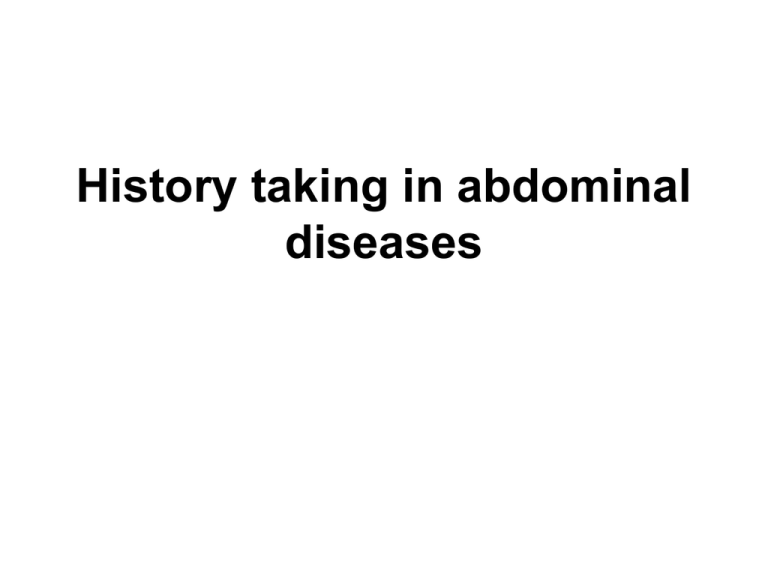
History taking in abdominal
diseases
History taking
• Family history
– Colon cancer
– Gallstones
History taking
•
•
•
•
•
•
•
Factors, habits and previous
diseases
Diet
Drugs
Alcohol
Smoking
Transfusion
Iv. drug abuse
Lifestyle
History taking - summary
•
•
•
•
•
•
•
•
•
•
Abdominal pain
Dysphagia
Nausea and vomiting
Anorexia and unexpected weight loss
Abdominal gas
Abdominal distension
Diarrhea
Constipation
Gastrointestinal bleeding
Jaundice
History taking
Abdominal pain
•
•
•
•
•
•
•
Localisation
Type
Severity
Chronology
Aggravating or relieving factors
Associated symptoms
Radiation of pain
Diffuse abdominal pain
•
•
•
•
Peritonitis
Intestinal obstruction
Irritable bowel syndrome
Tense ascites
Acute abdomen
•
•
•
•
•
•
•
•
•
•
Peritonitis
Appendicitis
Bowel or gastric perforation
Gallbladder perforation
Intestinal obstruction (ileus)
Mesenterial ischaemia
Extrauterine pregnancy (ectopic pregnancy)
Acute necrotising pancreatitis
Biliary colic
Renal colic
History taking
Other causes abdominal pain
•
•
•
•
•
•
•
•
Diabetic ketoacidosis
Hyperthyroidism
Acute intermittent porphyria
Hypercalcemia, hyperkalemia
Vasculitis
Pneumonia
Sickle cell crisis
Herpes zoster
Radiation of pain
• Ulcer disease: to the back
• Biliary pain: to the back, right scapula,
right shoulder
• Pancreatic: band-like, to the back
• Kidney, ureter: to the genitalia, groin
• Splenic: left shoulder
History taking
Substernal pain
Cardiac pain
Esophageal pain
Radiation: left
Type: pressing,
constricting
Aggravating factors:
physical activity,
stress
Relieving factors:
nitrates
Associated symptoms:
dyspnoea, sweating
Radiation : back
Type:burning,
spasmodic
Aggravating factors:
body position, eating
Relieving factors:
antacid
Associated symptoms:
dysphagia,regurgitation
History taking
Dysphagiadifficulty in swallowing
• Where is the food „hanging up”?
oropharyngeal or esophageal
• Difficulty to swallow liquids?
• Odynophagia- painful swallowing
History taking
Weight loss
• Is it associated with anorexia?
• Chronology
• Severity (significant:> 5%
of body weight)
• Underlying diseases
• Causes:
general disorders: diabetes, hyperthyroidism,
chr.infections,malignancy, medications
behavioral disorders: anorexia nervosa, depression
GI disorders: malignancy, malabsorption,
hepatic, biliary, pancreatic diseases
History taking
Nausea and vomiting
• Organic, functional or psychogenic?
•
connection with meals
• accompanied by weight loss
• Content of the vomit
•
•
•
•
•
•
Factors: taste, smell, color, pH
Subtypes: acid : reflux disease, duodenal ulcer
bile: bilio-pancreatic diseases
undigested food: obstruction of the
upper GI
faeces (miserere): bowel obstruction
(ileus)
blood: ie. ulcer, tumor, oes.varix
History taking
Abdominal gas
• Belching, bloating (meteorism),
flatulence
• Causes
– Aerophagia (habitual, poor dentition, inadequate
chewing, rapid eating)
– GI motor dysfunction or obstruction
– Malabsorption, maldigestion
– Bacterial overgrowth
History taking
Bowel movement
Factors: frequency, volume, fluidity, color,
associated sensations, change in bowel habits,
stool calibre
• Diarrhea
> 300 g of stool/day
more than 3 loose or watery
stools/day
• Constipation two or less stools/week
History taking
Bowel movement
• Stool alterations
– Color
– Content
- hypocholic, acholic
- pleiochromic
- bloody
- mucus
- blood
- fat - steatorrhea
- undigested proteins creatorrhea
History taking
Bowel movement
• Constipation
– Chronic or recent onset
• Causes
•
•
•
•
•
•
•
Decreased fluid and/or food intake
Functional (irritable bowel syndrome)
Medications
Hypothyroidism
Fecal impaction
Rectal or colon cancer
Chronic debilitating disease
History taking
GI bleeding
• Classification
– Hematemesis
– Melena
– Hematochezia
– Occult bleeding
- fresh blood
- coffee ground
- blood on the stool
- blood mixed with the
stool
History taking
Jaundice
• Observe it in bright, natural light
• First time you can observe on the sclerae
History taking
Jaundice
• Important anamnestic factors
• Color of the skin: overproduction: lemon
obstructive: dark-yellow,
greenish
• Color of the stool: overproduction: dark, greenish
(pleiochromic)
obstructive: hypocholic, acholic
• Color of the urine: overproduction: cherry-red
obstructive: dark, brown
• Associated symptoms: anemia, pain, fever,
hepatomegaly, splenomegaly, ascites
Physical examination of the
abdomen
1.Inspection
2.Auscultation
3.Percussion
4. Palpation
Position of the patient
Physical examination
Inspection
• Configurations of the abdomen
in the level or above or below the chest
apple-type : visceral obesity - cardiovascular
risk
pear-type : gluteal obesity
• Abdominal skin
•
•
•
•
•
•
striae : white, livid (pink)
hernias
veins : caput Medusae
visible peristalsis
visible pulsations
scars
Physical examination
Abdominal distension
• Generalised
• Localised
•
•
•
•
•
•
•
•
•
•
•
•
Obesity
Pregnancy
Ascites
Bowel obstruction ileus
• Big ovarian cyst
• Peritonitis
Hepatomegaly
Splenomegaly
Polycystic kidney
Gastric distension
Inflammatory mass
Tumor
Obstructed bladder
Hernia
Physical examination
Auscultation
• Bowel sounds
• above the umbilicus or in the RUQ
• normal: 5-35/min, clicks and gurgles
• altered: absent: paralytic ileus
hyperperistalsis: diarrhea,
mechanical bowel obstruction
• Bruits
• arterial
aortic, renal, iliac arteries
• Friction rubs spleen, liver, peritonitis
• Succussion splash normal: above the
stomach
pathologic: gastric or bowel obstruction
Physical examination
Percussion
• Meteorism
• Liver span midclavicular line: 6-12 cm
midsternal line: 4-8 cm
• Splenic dullness
norm: in the midaxillary
line
pathological:dullness in the ant. axillary line
during inspiration
• Liver or/and splenic dullness absent:
perforation
Ascites
shifting dullness
Physical examination
Palpation
• Position
• Warm hands, short fingernails
• Approach slowly, avoid quick
movements
• Exemine tender areas at last
• Watch the patient’s face
Physical examination
Palpation
1. Light palpation
a.
b.
muscular resistance - guarding defense musculaire
alterations in the abdominal wall
Physical examination
Palpation
2. Deep palpation
a. assessing abdominal masses
b. assessing abdominal tenderness
Physical examination
Palpation
• Characteristics of an abdominal mass
1.
2.
3.
4.
5.
6.
7.
8.
location
size
shape
consistency
surface
tenderness
movable or fixed
shifting by respiration
Physical examination
Palpation of the liver and
spleen
• Characteristics:
1. size
2. surface
3. edge
4. consistency
5. tenderness
(6. liver pulsation)
Physical examination
Palpation of the gallbladder
• Hydrops vesicae felleae
Curvoisier’s sign - painless enlargement of
the gallbladder due to cancer of the head of
the pancreas
Murphy’s sign - RUQ pain aggravated by
inspiration - acute cholecystitis
Physical examination
Palpation of the aorta
•
•
•
•
to the left of the midline
normal: < 3-4 cm
>6 cm: aortic aneurysm
transmitted pulsations: pancreatic or
gastric tumor, pseudocyst of the
pancreas
Physical examination
Rectal digital examination
•
•
•
•
•
•
Perianal diseases fistulas, masses
Anal alterations hemorrhoids, fisssuras, masses
Rectal alterations polyp, neoplasm, ulcer
Prostate gland
Douglas’s space
Stool on the glove

